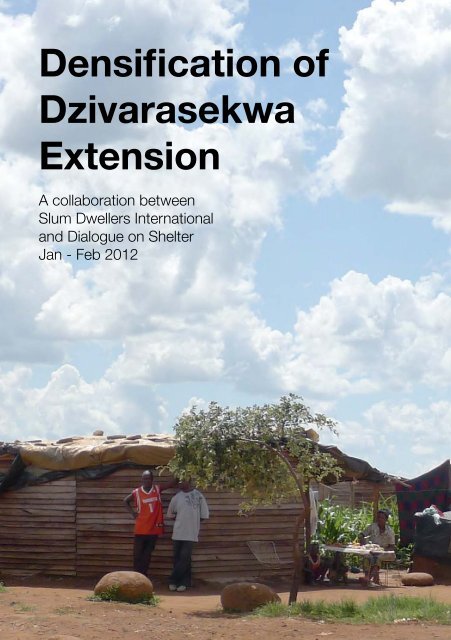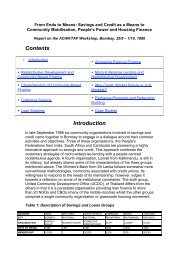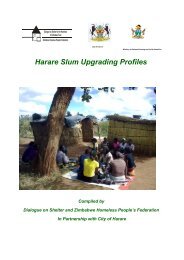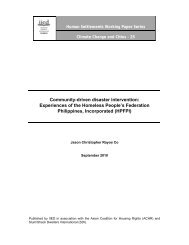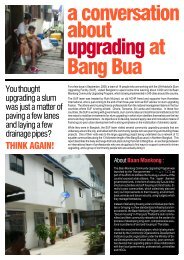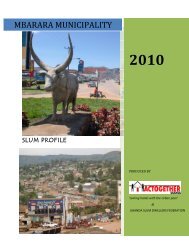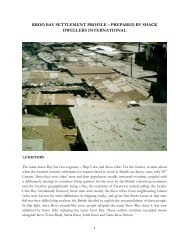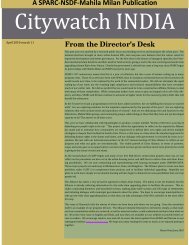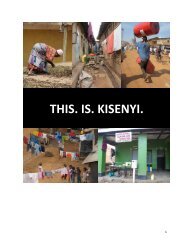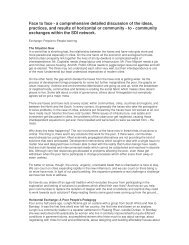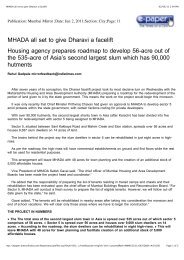Densification of Dzivarasekwa Extension - Shack/Slum Dwellers ...
Densification of Dzivarasekwa Extension - Shack/Slum Dwellers ...
Densification of Dzivarasekwa Extension - Shack/Slum Dwellers ...
- No tags were found...
You also want an ePaper? Increase the reach of your titles
YUMPU automatically turns print PDFs into web optimized ePapers that Google loves.
<strong>Densification</strong> <strong>of</strong><strong>Dzivarasekwa</strong><strong>Extension</strong>A collaboration between<strong>Slum</strong> <strong>Dwellers</strong> Internationaland Dialogue on ShelterJan - Feb 2012
Contents +IntroductionBackgroundGreenfield Housing ProblemGetting StartedConsultation BeginsDesign DevelopmentThis report is intended to document and share aspects <strong>of</strong> a currentlyongoing collaborative project between <strong>Slum</strong> <strong>Dwellers</strong> Interntional (SDI) andDialogue on Shelter (DOS).The focus <strong>of</strong> this project was to use the slum upgradement, <strong>of</strong> <strong>Dzivarasekwa</strong><strong>Extension</strong>, as an opportunity to develop new affrodable housing modelsthat could sustainably increase the density than the status-quo. For this,an architect from SDI, Greg Bachmayer, worked in the <strong>of</strong>fices <strong>of</strong> DOSbetween 15 January and 16 February 2012, in Harare, Zimbabwe.Second Round ConsultationLast Design (within this period)Row-HouseTerracesHopefully, this will explain in plain terms, the technical and social processesthat these projects go through, what they intend to achieve and where theyare eventually heading. Even though the work is still ongoing, the reportfocuses on the timeframe mentioned above. This should help give aninsight into the processes, rather than being an academic documentation<strong>of</strong> it.Where To From Here?Written by Greg Bachmayer (SDI)All images + drawings unless noted by Greg Bachmayer
Background<strong>Dzivarasekwa</strong> <strong>Extension</strong> (DZ Ext.), located18km west <strong>of</strong> Harare, was established by thegovernment in 1993. Over 2000 families originallyresided here. In 2004 some <strong>of</strong> these familieswere allocated plots in the Hatcliffe <strong>Extension</strong>allocation. The 2005 Operation Murambatsvinaevictions sent 150 familes returning to DZ Ext.DZ Ext. is located on state owned land which was allocated to theZimbabwe Homelss People’s Federation (Federation) in 2007 by whatis now the Ministry <strong>of</strong> Local Government Rural and Urban Development(MLGRUD).Today, DZ Ext. is home to 450 families. Asthe name suggests, it is an extension to<strong>Dzivarasekwa</strong> Main (DZ). DZ was establishedin the late 1950’s as a residential area fordomesetic workers, employed in the nearby,and formerly white only areas <strong>of</strong> Malboroughand Mabelreign. DZ Ext. sits on the fringe <strong>of</strong>DZ and lacks basic amenities provided to thecentral area <strong>of</strong> the suburb, such as proper roads,drainage, electricity and sewerage. The area isalso on the fringe <strong>of</strong> a neighbouring wetland,which further complicates the impacts <strong>of</strong> theheavy rains during the wet season.above: map <strong>of</strong> <strong>Dzivarasekwa</strong> in relation to Harare (source: Google)below: satellite photo <strong>of</strong> the locality (source: Google)Currently these residents are living in semipermanentstructures built from materialsincluding brick and mortar, wooden cabins,polythene material and sheet metal. Communaltoilets (eco-san and pit latrines) service theirsanitation needs and water is provided from 3boreholes in the settlement.
InsituUpgradingThe problem facing the residents <strong>of</strong> DZ Ext.is that they are lacking decent basic housingand adqequate amenity. The site, being on theperiphery <strong>of</strong> the city, makes connecting waterand sewer lines expensive. The challenge istherefore to deliver adequate services that canbe delivered at affordable costs. This scenario isnot unique to DZ Ext, as most cities in Zimbabwehave sprawled out, pushing the poor furtherfrom the centre where services are non-existentand costly to install.When the land was allocated to the Federation,it was zoned for high-density residentialdevelopment. The layout plan set aside 5cluster plots that would be developed at higherdensities to the norm in this area.As part <strong>of</strong> an ongoing partnership with the City<strong>of</strong> Harare, the Federation decided to use DZ Ext.as a pilot project. This would demonstrate thatincreased densities are viable and can deliveraffordable, adequate and aethetically pleasingphysical spaces for communities. This woulddemonstrate 3 proto-type designs, building 15housing units that the DZ Ext. community couldadopt for their own designs. The initial intent forthese designs were for models similar to walkup flats and semi-detatched housing.<strong>Densification</strong> was therefore a central issue as to how this could be achievedin a prevalent culture where for most, improved housing is synonymouswith free standing houses. Through increasing density, this would reducethe amount <strong>of</strong> land used, cost <strong>of</strong> services, cost <strong>of</strong> amenity provision andprovide an urban mass that could develop into a local hub.
GettingStartedThe initial designs were started between DOSand the City Architect in the City <strong>of</strong> Harare. Withthe City constantly overwhelmed with too manyissues and not enough resources, it takes a longtime to get these processes started and movingtoo. This ongoing scenario leads to significantdelays on delivery.SDI provided technical assistance, sending upan architect to workshop these plans over a 3week period. At the time <strong>of</strong> this, initial designshad been prepared by DOS and the Federation’stechnical team. The SDI architect worked withDOS’s Project Officer, who is a town planner,to develop the designs that would be used forconsultations with the community at DZ Ext.Upon arrival, consultation began with theFederation leaders at <strong>Dzivarasekwa</strong>. Prior to this,there had been discussions with the communityat DZ Ext. which had included visits to localitieswithin Harare that had varied higher densityhousing designs. At the first meeting, only 2designs from the initial set were presented. Arow house and a semi-detatched house.oppostie: initial site layout plan for a clusterby (DOS)
ConsultationBeginsThere were mixed comments as people foundissues understanding the plans properly.Furthermore, it was also difficult for them toimagine and understand the spaces drawnproperly, as most <strong>of</strong> them have had little or noexperience in this. Common patterns in thefeedback were that they wanted a sense <strong>of</strong>ownership and individuality. Design features suchas the continuous row houses, giving the effect<strong>of</strong> a on-going wall or the communal entrancesfor the semi-detatched houses were contrary tothis and were rejected. Demarcation was centralto achieving this sense <strong>of</strong> individuality.The comments from the initial consultationwere taken on board and with a new architect(from SDI), the designs were re-worked to tryand maximize spatial efficiency and explore newideas that could plug into these proto-types.The design changes weren’t a radical departurefrom the original plans but by building them as3D models, this allowed a more holistic view<strong>of</strong> the designs. This would also prove to be avaluable tool for communicating the designsto a community <strong>of</strong> people who had little or noexperience in reading architectural drawings.The designs were also discussed inhouse withinDOS and further comments were received.
ConsultationBegins(continued)Duplex housing drawings presented(by DOS):Front elevation (not to scale)Ground floor plan (not to scale)Side elevation (not to scale)Level 1 plan (not to scale)
DesignDevelopmentThe follow up presentation <strong>of</strong> designs tookplace in the community’s school hall, and usinga generator, computers were setup with aprojector to show the changes made.This time, three designs were shown instead <strong>of</strong>two: row-house, semi-detached terrace, and alow-rise apartment block, as the brief required.The ‘carpark’ <strong>of</strong> ideas being tested and modelled
DesignDevelopment(continued)The Semi-Detatched HouseIn developing this design, the floor plan wasopened up to economise and provide greaterflexibility in the space. This resulted in the openplan living arrangements.1The coloured boxes was an idea that usingextruded planter boxes, the individual dwellingscould be individualised by the residents. Thiswould be both through the nature <strong>of</strong> the plantsand the applied finishes, to be determined bythe owners.21. 3D perspective <strong>of</strong> a typical semi-detatcheddwelling.2. Ground floor plan - with the exception <strong>of</strong> thebathroom, the bottom floor becomes one bigroom.3. Level one floor plan - rearragnement <strong>of</strong> thestaircase and access allowed the bedrooms tobecome more generous.3
DesignDevelopment(continued)The Row HouseSimilar to the semi-detatched dwelling, the floorplans were opened up, removing unnecessarycorridors that could be used as habitablespaces. The kitchen and dining areas wereextended and enlarged as a result.1The bedrooms and bathrooms were also shiftedforward, creating an entrance alcove and tobreak up the uniform facade the prior facadecreated. To further distinguish this in the exteriorform, the two bodies would have opposingraked rooves so that from either front or backone half would read differently to the other,further breaking up the visible form. This couldbe also be distinguished through varying theexterior treatments/finishes applied to either <strong>of</strong>these forms, also allowing for greater sense <strong>of</strong>identity and variation.21. 3D perspective <strong>of</strong> row houses with thebedrooms finished in a variety <strong>of</strong> colours2. Row house plans - the two areas, livingand bedrooms, differentiated through the shift.These could possibly be built separately indifferent stages.
DesignDevelopment(continued)The Walk-Up Apartment BlockThis followed on from prior designs, whichused the row-house layouts, stacked up. Indeveloping the row-house design, a similarsensibility <strong>of</strong> opening up the space was appliedto this design. The planter ideas from the semidetatcheddwelling were adopted and the use<strong>of</strong> alternating windows would help break up theuniformity <strong>of</strong> the structure.11. 3D perspective <strong>of</strong> apartment block withthe varying window arrangements and planterboxes. The facade was largely un-resolvedat this point as the planning and arrangementwas still being experimented with options beingtested.22. Typical floor plans - almost identical to therow-house except for the arrangement <strong>of</strong> thebathrooms and square footprint <strong>of</strong> each unit.As mentioned above, resolving the design issueshere were a bit more challenging in the smalltime frame allowed, and thus less resolved.
SecondRoundConsultationThe concept <strong>of</strong> densification was not acceptedby the generality <strong>of</strong> the community at DZ Ext. Thedesign that caused the most controversy wasthe apartment blocks. Some felt that they were‘tricked’ or ‘pushed’ into apartments instead <strong>of</strong>houses. The reality was that the governmenthad already zoned and commissioned this jobto take on these densification requirements.Regardless, even when this was communicated,it was not fully accepted by the community.The community believed apartments were moreexpensive to build and it would mean that halfthe families wouldn’t have access to their ownprivate garden, an important issue to them.There was also the belief that these would notbe maintained properly. This was the case withthe examples they were familiar with in Mbare,which had gone into neglect and decay. Thebelief was that these buildings would meet asimilar fate.
SecondRoundConsultation(continued)The semi-detached terraces were met with awarmer interest but there was still doubt aboutthis building type.Once the re-worked row-houses werepresented, they were met with applause, as thatis what they all wanted for themselves. Just asmuch, there was also a strong response to thesuggestion that these could be incrementallybuilt. This would be critical in making thesehouses affordable for them.Other comments worth noting was that once thedesigns were understood, the idea <strong>of</strong> open planliving room, kitchen and dining were rejected.For a variety <strong>of</strong> reasons, they all preferred usesto have their own separate rooms. It becameobvious that there was need for more time thanhad been originally allowed for.
Last Design(within thisperiod)There wasn’t enough time to redesign, meetwith the City Architect at the City <strong>of</strong> Harare,present to the community and fully documenteverything. Even with a full week extension.The reworked designs focused on trying toprovide the following things that appeared to becrucial in the meetings:1. Demarcation to allow individual’s a sense<strong>of</strong> ownership and individuality2. Provide a private garden/outdoor space– everyone wants this for planting/gardening and it also reduces needfor maintenance <strong>of</strong> communal spaces.People will take very good care <strong>of</strong> theirown spaces but won’t make an effort if itis communal (evident in Mbare)3. Design for incremental additions –increase affordability, and it will alsoallow for a variety <strong>of</strong> housing, even ifthey all stem from the same model.On top <strong>of</strong> this, both the City <strong>of</strong> Harare and DOSwanted to use this as an opportunity to try dosomething new or different and to challenge thestandards where possible. The row house wasfurther tweaked to fully adopt these ideals
Row-HouseIncremental is the key here. The plans 1-4 onthe right indicate how the residents would begin12with a core unit, with all the bare living essentials.As money becomes available, they can beginto add bedrooms and eventually open up theliving room. There were other practicalities thatneeded to be accounted for as they were onlyrevealed by authorities and locals as the processprogressed.1 - 4. Plans developing from a 1bedroom houseto a 3 bedroom.Stage 1 Stage 25. 3D perspective fine-tuning the initial ideashown in the previous design.345Site Area: 150 sqmStage 1 area: 43 sqmStage 2 area: 68 sqmStage 3 area: 80 sqmStage 2 - living room extension Stage 3
TerracesThe idea <strong>of</strong> a terrace was arrived at by combiningthe need for a private outdoor space within thedensity <strong>of</strong> the walk-up apartments. Stackingdwellings atop one another prevented accessto ground floor gardens. The semi-detachedmodel used the two narrowest ends for accessto the garden. Instead, a single long edgecould be planned around to allow for greateraccess to a garden and allow for a more densearrangement, than either two <strong>of</strong> the prior modelsallowed for.1 2The plans could also be built incrementally withthe living rooms used as bedroom until thefunds for an upstairs were raised.3Site Area: 64 sqmFootprint area: 39 sqmGarden area: 25 sqm
Terraces(continued)The rotating arrangement <strong>of</strong> the individualresidences would create a variety <strong>of</strong> streetfrontconditions, breaking up the mass, andminimising privacy issues. The top floor additionscould also be finished in a variety <strong>of</strong> ways andthe fencing (if used) would also provide furthervariety amongst the rhythm <strong>of</strong> extending blankwalls which would frame this.1. Ground floor plan - everything (except the bathroom) would open uponto the garden, making these spaces as breathable as possible andencouraging this spaces to extend into one another.2. First floor plan - The bedrooms would predominatly look down into thecourtyard3. The arrangement <strong>of</strong> a 4 residences which would make up one block.Each residence looking away from one another.4.(below) 3D model <strong>of</strong> a typical streetscape <strong>of</strong> completed terraces.
Where ToFrom Here?Whilst the designs have begun to deal with theseissues, there is still room for further development.There is still capacity to further develop theincremental design to adopt a strategy for theowners to also rent out rooms to subsidize theirliving expenses.With the terrace model this would look at howthe plans could be tweaked to allow for theliving room to be used as an additional bedroomand also allow for further vertical developmentas time goes on. With the row-houses, howcan they build up, possibly fitting 2 separateresidneces on the one plot.The designs approached the agenda from astrategic perspective. With the strategy in place,the trimming the fat and tweaking the planningcan be done accordingly. From here, spacescan be further economised made more efficient.There was not an opportunity to get feedbackfrom the community so there is no doubt thatthey will also have some critical feedback whichwill also need to be taken on board too.The designs will then be tweaked in response to the community feedbackgiven. The City <strong>of</strong> Harare’s consultant team will also review the designsand see what will be required for this building to work structurally andconstruction wise too.DOS will also coordinate the construction <strong>of</strong> a frame for these prototypes sothat the federation members properly understand the scale <strong>of</strong> the spaces.By bringing the design to the human scale, this reduces any capacity themembers can claim for mis-understanding not only what was happeningin the drawings but the scale <strong>of</strong> them too.Finally, once this process is approved for, the proto-types will be constructedand from there, the feedback cycle will continue. In the end, the new housingbuilt at DZ Ext. will have been through so many consultation processes,that it would be hard to deny that the members have been co-producers inthis process. The idea that we are working towards is that, by this stage,the designs will be so well polished, that the:1. members will be enthusiastic about investing their time, efforts andfinances further2. The proto-types will be willfully picked up by other communities in theirupgradements, and incorporated into their plans.3. The buildings will be an improvement on the status quo. This will be inregards to affordability, aesthetics, planning and environmentally. In short,these should be building blocks <strong>of</strong> a better community than what theprevious housing models allowed for.


